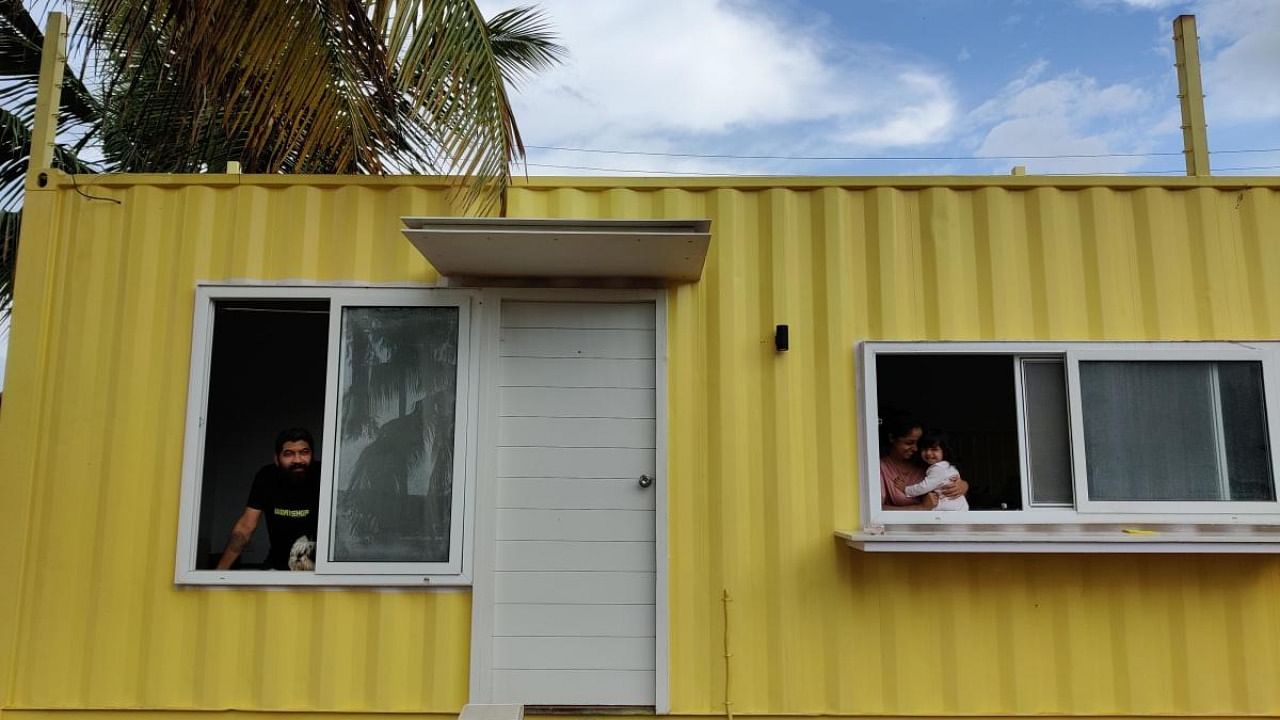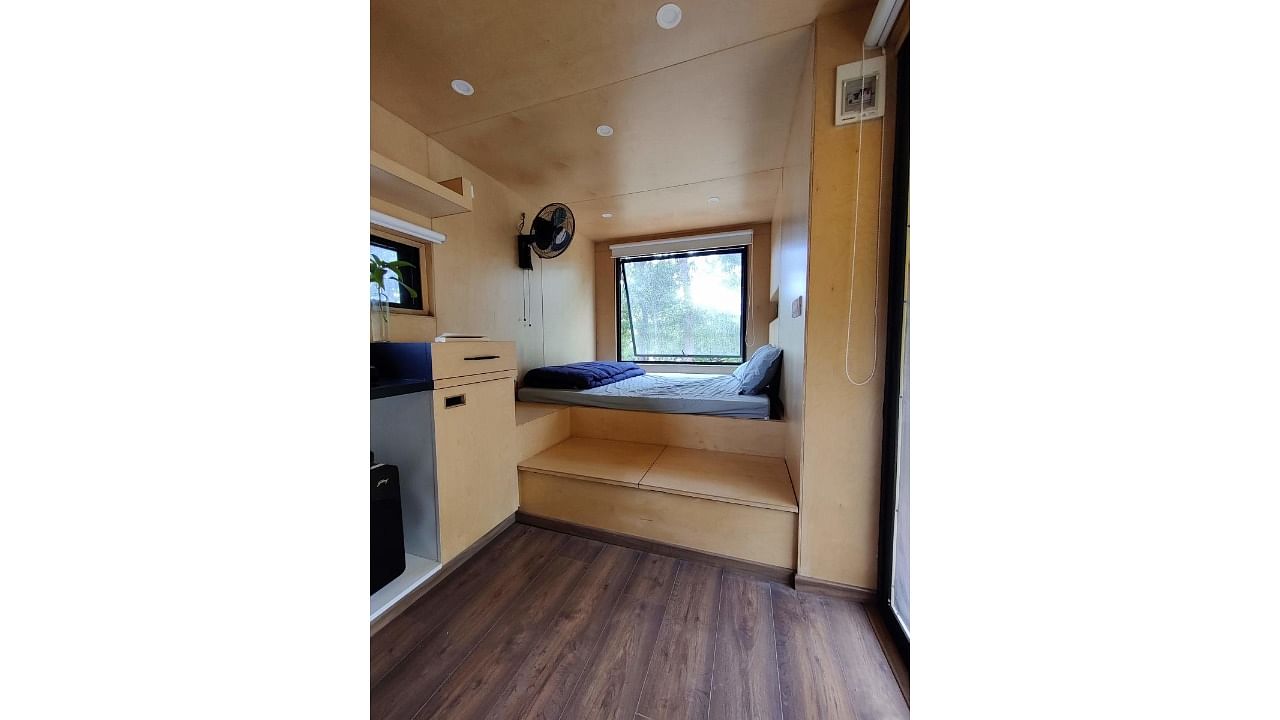

Anabelle Viegas’ home near Nandi Hills is a head-turner. It is not your regular cement structure but a shipping container turned into a living space.
Yes, at 320 sq ft, it is smaller than most 1BHK flats in Bengaluru. But it is big enough for Viegas, her husband and their baby girl to stay over whenever they take a short vacation.
“We did not buy this home just because it is made from a container or because tiny houses are a trend. My husband and I are outdoorsy people and being stuck in the city because of the pandemic was getting to us. We were looking for a home that could be built fast,” says Viegas, an architect herself.
Her home was manufactured off-site and delivered in 90 days last December. It came with a living room, kitchenette, bedroom and toilet, and a coat of baby yellow paint on the outside. It was offloaded on four concrete pedestals and plugged into electricity, water and sewage connections. Earthing was done, and two days later, it was ready to move in.
Homes built from out-of-use shipping containers are not a new concept, nor are they alien to Bengaluru.
Twelve years ago, Kameshwar Rao had co-built a house for his family in Ramamurthy Nagar, using four containers. He was probably the first in India to do so. His company went on to build eight such homes, in Andhra Pradesh and Tamil Nadu.
So will this new coming of the container homes last? The Habitainer, the construction company from Bengaluru that did Viegas’ home, is upbeat. “We have delivered 20 container homes to families across Kanakapura, Sakleshpur, Nandi Hills, Hosur and Mysuru,” says a company representative.
Now they are developing nine more for developers to install inside their gated communities. “We may do 60 more by the end of the financial year because we have received a lot of enquiries,1,500 actually,” he says.
The buyers are mostly industrialists, techies and architects in the 35-55 age group. They own land and are looking for alternative ways of living.
“They choose a container home for their second home outside the city, as a farmhouse, as a man cave. A woman gifted it, instead of a tent, to her daughter,” the representative says. Viegas calls their Nandi Hills home “a dollhouse” — a present for her girl Arianna.
Others want to build Airbnb ‘container’ rentals in the mountains to get over the complexity of building cement houses.
The biggest draw is the speed at which these can be manufactured, delivered and set up.
Take the case of businessman Arun Choudhari, 49. He had booked a 3BHK container home of 1,000 sqft for his nephew near the Kempegowda airport. This was a conscious choice to avoid builder troubles and delays that come with buying conventional homes in India. The Habitainer team plans to deliver it by year-end.
Then there is the advantage of flexibility. Preetham Daniel says he built a 20-foot container home near Nandi Hills to hang out with fellow-bikers after their rides. The idea fizzled out when the lockdown eased and people started biking away further.
Now the 42-year-old is doing it up as a weekend rental home for those who
want to experience minimalist living. If this idea doesn’t fly, he will have his home picked and dropped at a motorcycle
training centre he runs 11 km from the city, and use it as an office.
A container home is a container at the end of the day. You can load it on a truck, transport it to a different city and start living almost immediately, as the interior remains intact.
This may, however, not work as swiftly when the homes are built in hybrid style, using containers, concrete, wood and more.
Can container homes become permanent homes? Daniel doubts it: “That hasn’t even happened in the West.”
But The Habitainer representative is more hopeful as he says, “At least 20% of our clients have moved in permanently.”
Know this before you buy one
How big are container homes?
Containers are available in two sizes – 20-footer and 40-footer.
A 20-footer can serve as a 1 BHK home while a 40-footer can be used to create two rooms. You can attach more containers on the side or stack them on top to add rooms. Keetwonen, a student housing project in Amsterdam, is made from a thousand shipping containers arranged in multi-storey blocks.
How much weight can it hold?
Containers are designed for shipping so they can hold a lot more weight than is required in a conventional home. The body of a 20-foot container weighs 3,000 kg and it can take a payload capacity of 25,000 kg.
How long do these homes last? Do they rust?
The container body is made from corrosion-resistant steel (called corten steel). It usually lasts for 30 to 45 years.
Do the walls make a noise like tin sheets?
Yes, and so your architect should work on sound-proofing the home.
Does it get hot inside?
It depends on the design. Architects usually add large and multiple windows for cross-ventilation.
Do they need maintenance?
Like concrete homes, they call for occasional painting, plumbing and electrical fixes.
Are they a good investment choice?
Reselling the container fetches you the same money as scrap steel. Given the current rate (Rs 30 to 35 per kg), it can fetch Rs 90,000 to a lakh.
Watch out...
Ensure the containers used are not more than 15 years old, broken or structurally weak.
(Inputs provided by experts)
More prefabricated home options
Prefabricated homes are ones where parts are built in factories and assembled at the destination plot. They save time, promote recycling, and are said to be cost-effective.
In India, prefab homes are made from shipping containers, bamboo, plastic, and with light gauge steel framing. The Tata Group has launched a prefab home line called Nest-in. The market is projected to grow at 8.5% between 2021 and 2026.
Wallet factor
A container home can cost from Rs 3 lakh to Rs 35 lakh, depending on the number of containers used, and the customisation and sophistication involved. Shipping is extra.